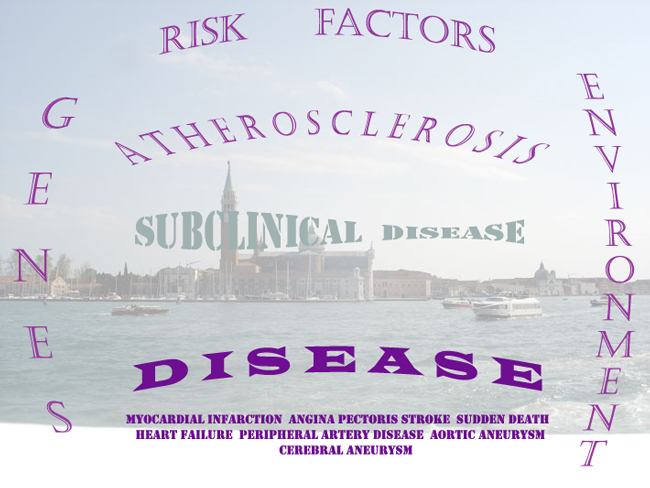|
CARDIOVASCULAR RISK FACTORS |
 |
Risk factors are certain conditions that increase the onset of atherosclerotic based
cardiovascular diseases: Acute myocardial infarction, Angina pectoris, Stroke, Brain
haemorrhage , peripheral artery disease.
The greater the number of risk factors, the greater will be the possibility of a
person becoming subject to a cardiovascular disease.
|
|
|
|
Risk factors can be divided into “Non modifiable factors ” and “Modifiable
factors ” |
|
|
|
NON MODIFIABLE RISK FACTORS: |
|
These are the risks that cannot be modified by the person’s change in life-style
or by various types of treatment. |
|
- Sex: Males are more subject than females. |
|
- Age: The risk of cardiovascular diseases increases with age. |
|
- Race: Africans, South-East Asian populations, and Hawaiians, whether
native, or their descendents have a larger risk have a greater risk of heart
attack. |
|
- Family history. The risk increases if there has been history of heart
attacks among parents, brothers, and sisters, under the age of 55 in male
members, and under the age of 65 in female members. |
|
- Menopause. A woman’s risk of cardiovascular diseases increases after
the menopause. |
|
|
|
MODIFIABLE RISK FACTORS: |
|
Modifiable risk factors can be modified, controlled, treated, and reduced. |
|
- Smoking. Stop smoking. Non-smokers are exposed to risk as a result of
passive smoking. |
|
- High blood pressure (Hypertension ). |
|
Optimal level < 135/85 mm Hg |
|
- Diabetes |
|
Optimal level: fasting glycaemia < 126 mg/dl |
|
In normal patients: Glycosylated haemoglobin (A1c) < 6.0 mg/dl. |
|
Hemoglobin A1c test < 6.5 mg/dl if you have diabetes. |
|
- Cholesterol and Triglycerides |
|
Excessive fats, especially saturated fats in the diet contribute towards the
build-up of lipidic deposits in the arteries, and therefore towards the forming
of atherosclerotic plaques. The most important fats in the blood are Cholesterol
and Triglycerides. |
|
Cholesterol, Optimal level: |
|
Cholesterol Total < 200 mg/dl |
|
Cholesterol LDL: - In patients without risk factors < 130 mg/dl |
|
|
|
- In patients with heart or vascular diseases < 70 mg/dl |
|
The higher your good Cholesterol ( HDL) the better, and in any case > 40 mg/dl |
|
Triglycerides, Optimal level: |
|
- In patients without risk factors < 200 mg/dl |
|
- in other patients < 150 mg/dl |
|
- Overweight |
|
Ideal amount: |
|
Normal: (Body Mass Index) BMI 18,5 – 24,9 Kg/m2 |
|
overweight: BMI 25 – 29,9 Kg/m2 |
|
obesity: BMI > 30 Kg/m2 |
|
Abdominal/waist circumference: |
|
- Males < 100 cm (40 inches) |
|
- Females < 90 cm(35 inches) |
|
Chinese, South-East Asians and descendents: |
|
- Males < 100 cm (40 inches) |
|
- Females < 90 cm (35 inches) |
|
Waist index/even < 1 |
|
- Previous cardiovascular diseases or myocardial revascularization
(CABG,PCI), peripheral vascular procedures. |
|
- Sedentary lifestyle. not enough exercise. Carry out moderate physical
exercise for at least 30 minutes a day. |
|
- Dieta. Follow a Mediterranean diet, low in saturated fats. Reduce
salt and sugar. Low fruit and vegetable consumption is also a cardiovascular
risk factor. |
|
- Excessive alcohol intake: |
|
Ideal amount: |
|
< 100 ml of wine a day, or |
|
< 350 ml of beer, or |
|
< 33 ml of 80-proof spirits. |
|
Never drink on an empty stomach. Replace alcohol with non-alcoholic drinks or
fruit juice. |
|
- Stress-related factor. Depression, unemployment, divorce or
separation, mobbing, work stress, can all have a negative effect on the
cardiovascular system. |
|
- Erectile dysfunction. Erectile dysfunction is defined as the
incapacity to reach and/or maintain an erection that is sufficient for a
satisfying sexual relationship. This can be one of the first signs of a
cardiovascular disease. |
- Stroke risk factors.
These are the same as those described for
Ischemic heart disease.
In addition there are certain risk factors that are specific for stroke. These
are:
- Atrial fibrillation;
- Cardiomyopathy (heart muscle disease);
- Heart valve diseases;
- The presence of artificial heart valves, especially if mechanical;
- Congenital heart disease;
-Hypercoagulable states (thrombophilias), acquired and hereditary;
- Sickle cell disease (also called sickle cell anemia) .This is a genetic
disorder that mainly affects African- American and Hispanic children. "Sickled"
red blood cells also tend to stick to blood vessel walls, which can block
arteries to the brain and cause a stroke.
|
|
|

